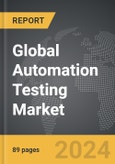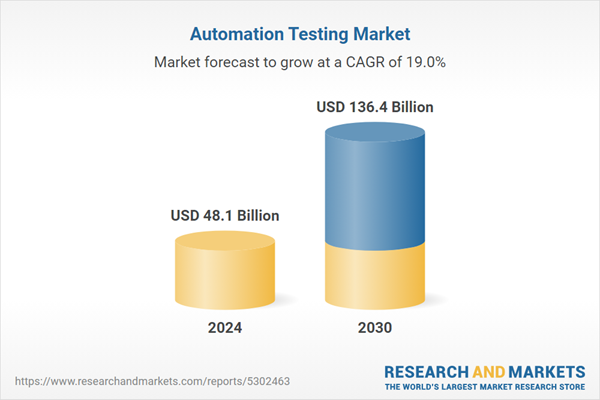The global market for Automation Testing was valued at US$48.1 Billion in 2024 and is projected to reach US$136.4 Billion by 2030, growing at a CAGR of 19.0% from 2024 to 2030. This comprehensive report provides an in-depth analysis of market trends, drivers, and forecasts, helping you make informed business decisions. The report includes the most recent global tariff developments and how they impact the Automation Testing market.
Segments: Component (Services, Testing Types); Vertical (BFSI, IT & Telecom, Automotive, Healthcare & Life Sciences, Retail, Government & Public Sector, Manufacturing, Other Verticals).
Geographic Regions/Countries: World; United States; Canada; Japan; China; Europe (France; Germany; Italy; United Kingdom; Spain; Russia; and Rest of Europe); Asia-Pacific (Australia; India; South Korea; and Rest of Asia-Pacific); Latin America (Argentina; Brazil; Mexico; and Rest of Latin America); Middle East (Iran; Israel; Saudi Arabia; United Arab Emirates; and Rest of Middle East); and Africa.
The analysts continuously track trade developments worldwide, drawing insights from leading global economists and over 200 industry and policy institutions, including think tanks, trade organizations, and national economic advisory bodies. This intelligence is integrated into forecasting models to provide timely, data-driven analysis of emerging risks and opportunities.
Global Automation Testing Market - Key Trends and Drivers Summarized
What Is Automation Testing, and How Is It Shaping Modern Software Development?
Automation testing, a process of using software tools to execute pre-scripted tests on applications automatically, is transforming quality assurance (QA) in modern software development. Unlike manual testing, which requires significant time and human involvement, automation testing streamlines the testing process by running repetitive and complex test cases with minimal human intervention. It’s commonly used in large-scale software projects where ensuring stability, performance, and functionality across numerous scenarios is essential. By simulating real-world use cases, automation testing allows QA teams to identify and fix bugs early in the development cycle, reducing costly errors that could emerge later. This capability is particularly crucial in today’s fast-paced software environment, where continuous integration and continuous deployment (CI/CD) have become industry standards. Automation testing supports CI/CD by allowing developers to validate code changes quickly and efficiently, facilitating faster product iterations and increasing overall software reliability. As a result, automation testing has become an integral part of development strategies for organizations looking to deliver high-quality software that meets both user expectations and industry standards.How Does Automation Testing Drive Efficiency Across Different Testing Phases?
Automation testing is not a one-size-fits-all approach; it can be applied across various testing phases, each serving a unique purpose in the software development lifecycle. Unit testing, often the first level of testing, uses automation to validate individual components or functions of the code, ensuring they work as expected. Automated unit tests are invaluable for developers, as they quickly detect issues at the code level, making it easier to resolve bugs before they affect higher levels of functionality. Integration testing follows, where automated tests verify that different modules work together as intended, which is particularly beneficial for complex applications with interconnected components. Then comes functional testing, where automation checks if the software meets specified business requirements by simulating user interactions and workflows. At the final stages, performance testing, often automated, evaluates the system’s behavior under various loads, helping teams ensure scalability and stability in high-traffic conditions. The flexibility of automation testing across these phases not only accelerates the QA process but also provides comprehensive test coverage that improves product quality and reduces the risk of defects slipping into production. This systematic, phase-driven approach allows teams to deploy software with confidence, knowing that each layer of the application has been rigorously tested.What Are the Latest Technological Advancements Transforming Automation Testing?
Advancements in automation testing technology have made it more robust, accessible, and effective than ever before, driven by tools that harness artificial intelligence (AI), machine learning, and cloud-based platforms. AI-powered testing tools, for example, can intelligently identify and adapt to changes in the application’s user interface, reducing the need for manual updates to test scripts. This is particularly useful in agile development environments where UI elements can change frequently. Machine learning algorithms can analyze historical test data to predict the likelihood of new bugs, enabling prioritization of test cases for more efficient testing cycles. Cloud-based testing solutions have also gained traction, providing scalable and flexible platforms that allow teams to conduct testing across various environments and device configurations without the need for extensive physical infrastructure. Another significant development is the rise of low-code and no-code automation tools, which allow team members with minimal coding skills to create and execute automated tests, democratizing access to automation and making it a feasible solution for smaller QA teams. These advancements are collectively reshaping automation testing, making it faster, smarter, and more adaptable to the demands of rapid software development cycles.What Are the Key Growth Drivers in the Automation Testing Market?
The growth in the automation testing market is driven by several factors, including the increasing adoption of agile and DevOps methodologies, the demand for faster release cycles, and the need for quality assurance in complex software applications. As more organizations shift toward agile and DevOps practices, automation testing has become essential for supporting continuous testing within CI/CD pipelines, where frequent and iterative code changes are a standard requirement. The rising complexity of applications, particularly those with microservices architectures or multi-platform support, has also spurred demand for robust automation testing tools that can provide comprehensive testing coverage without slowing down development. Businesses are also increasingly focused on enhancing customer experience, which relies on releasing high-quality, bug-free software that meets users' performance expectations. In response, automation testing enables faster and more reliable testing of user interfaces, workflows, and integrations, ensuring that new features and updates are thoroughly vetted before they reach the end-user. Additionally, the shift towards digital transformation across industries has heightened the need for reliable testing solutions that can keep pace with rapid software innovations. Finally, the development of AI-driven and low-code automation tools has made automation testing more accessible and cost-effective, encouraging more companies, especially startups and SMEs, to invest in automation testing as a viable quality assurance strategy. Together, these factors contribute to the growing demand for automation testing solutions, solidifying its role as a fundamental component in modern software development and quality assurance practices.Report Scope
The report analyzes the Automation Testing market, presented in terms of units. The analysis covers the key segments and geographic regions outlined below.Segments: Component (Services, Testing Types); Vertical (BFSI, IT & Telecom, Automotive, Healthcare & Life Sciences, Retail, Government & Public Sector, Manufacturing, Other Verticals).
Geographic Regions/Countries: World; United States; Canada; Japan; China; Europe (France; Germany; Italy; United Kingdom; Spain; Russia; and Rest of Europe); Asia-Pacific (Australia; India; South Korea; and Rest of Asia-Pacific); Latin America (Argentina; Brazil; Mexico; and Rest of Latin America); Middle East (Iran; Israel; Saudi Arabia; United Arab Emirates; and Rest of Middle East); and Africa.
Key Insights:
- Market Growth: Understand the significant growth trajectory of the Services segment, which is expected to reach US$99.5 Billion by 2030 with a CAGR of a 18.1%. The Testing Types segment is also set to grow at 21.4% CAGR over the analysis period.
- Regional Analysis: Gain insights into the U.S. market, valued at $12.1 Billion in 2024, and China, forecasted to grow at an impressive 24.0% CAGR to reach $36.3 Billion by 2030. Discover growth trends in other key regions, including Japan, Canada, Germany, and the Asia-Pacific.
Why You Should Buy This Report:
- Detailed Market Analysis: Access a thorough analysis of the Global Automation Testing Market, covering all major geographic regions and market segments.
- Competitive Insights: Get an overview of the competitive landscape, including the market presence of major players across different geographies.
- Future Trends and Drivers: Understand the key trends and drivers shaping the future of the Global Automation Testing Market.
- Actionable Insights: Benefit from actionable insights that can help you identify new revenue opportunities and make strategic business decisions.
Key Questions Answered:
- How is the Global Automation Testing Market expected to evolve by 2030?
- What are the main drivers and restraints affecting the market?
- Which market segments will grow the most over the forecast period?
- How will market shares for different regions and segments change by 2030?
- Who are the leading players in the market, and what are their prospects?
Report Features:
- Comprehensive Market Data: Independent analysis of annual sales and market forecasts in US$ Million from 2024 to 2030.
- In-Depth Regional Analysis: Detailed insights into key markets, including the U.S., China, Japan, Canada, Europe, Asia-Pacific, Latin America, Middle East, and Africa.
- Company Profiles: Coverage of players such as AFour Technologies, Applitools, Astegic, CA Technologies, Capgemini and more.
- Complimentary Updates: Receive free report updates for one year to keep you informed of the latest market developments.
Some of the 34 companies featured in this Automation Testing market report include:
- AFour Technologies
- Applitools
- Astegic
- CA Technologies
- Capgemini
- Cigniti Technologies
- Codoid
- Cygnet Infotech
- Eggplant
- Froglogic
Tariff Impact Analysis: Key Insights for 2025
Global tariff negotiations across 180+ countries are reshaping supply chains, costs, and competitiveness. This report reflects the latest developments as of April 2025 and incorporates forward-looking insights into the market outlook.The analysts continuously track trade developments worldwide, drawing insights from leading global economists and over 200 industry and policy institutions, including think tanks, trade organizations, and national economic advisory bodies. This intelligence is integrated into forecasting models to provide timely, data-driven analysis of emerging risks and opportunities.
What’s Included in This Edition:
- Tariff-adjusted market forecasts by region and segment
- Analysis of cost and supply chain implications by sourcing and trade exposure
- Strategic insights into geographic shifts
Buyers receive a free July 2025 update with:
- Finalized tariff impacts and new trade agreement effects
- Updated projections reflecting global sourcing and cost shifts
- Expanded country-specific coverage across the industry
Table of Contents
I. METHODOLOGYII. EXECUTIVE SUMMARY2. FOCUS ON SELECT PLAYERSIII. MARKET ANALYSISCANADAITALYSPAINRUSSIAREST OF EUROPESOUTH KOREAREST OF ASIA-PACIFICARGENTINABRAZILMEXICOREST OF LATIN AMERICAIRANISRAELSAUDI ARABIAUNITED ARAB EMIRATESREST OF MIDDLE EASTIV. COMPETITION
1. MARKET OVERVIEW
3. MARKET TRENDS & DRIVERS
4. GLOBAL MARKET PERSPECTIVE
UNITED STATES
JAPAN
CHINA
EUROPE
FRANCE
GERMANY
UNITED KINGDOM
ASIA-PACIFIC
AUSTRALIA
INDIA
LATIN AMERICA
MIDDLE EAST
AFRICA
Companies Mentioned (Partial List)
A selection of companies mentioned in this report includes, but is not limited to:
- AFour Technologies
- Applitools
- Astegic
- CA Technologies
- Capgemini
- Cigniti Technologies
- Codoid
- Cygnet Infotech
- Eggplant
- Froglogic
Table Information
| Report Attribute | Details |
|---|---|
| No. of Pages | 89 |
| Published | April 2025 |
| Forecast Period | 2024 - 2030 |
| Estimated Market Value ( USD | $ 48.1 Billion |
| Forecasted Market Value ( USD | $ 136.4 Billion |
| Compound Annual Growth Rate | 19.0% |
| Regions Covered | Global |









